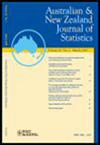Measurement errors in semi-parametric generalised regression models
Abstract
Regression models that ignore measurement error in predictors may produce highly biased estimates leading to erroneous inferences. It is well known that it is extremely difficult to take measurement error into account in Gaussian non-parametric regression. This problem becomes even more difficult when considering other families such as binary, Poisson and negative binomial regression. We present a novel method aiming to correct for measurement error when estimating regression functions. Our approach is sufficiently flexible to cover virtually all distributions and link functions regularly considered in generalised linear models. This approach depends on approximating the first and the second moment of the response after integrating out the true unobserved predictors in any semi-parametric generalised regression model. By the latter is meant a model with both linear and non-parametric effects that are connected to the mean response by a link function and with a response distribution in an exponential family or quasi-likelihood model. Unlike previous methods, the method we now propose is not restricted to truncated splines and can utilise various basis functions. Moreover, it can operate without making any distributional assumption about the unobserved predictor. Through extensive simulation studies, we study the performance of our method under many scenarios.

 求助内容:
求助内容: 应助结果提醒方式:
应助结果提醒方式:


